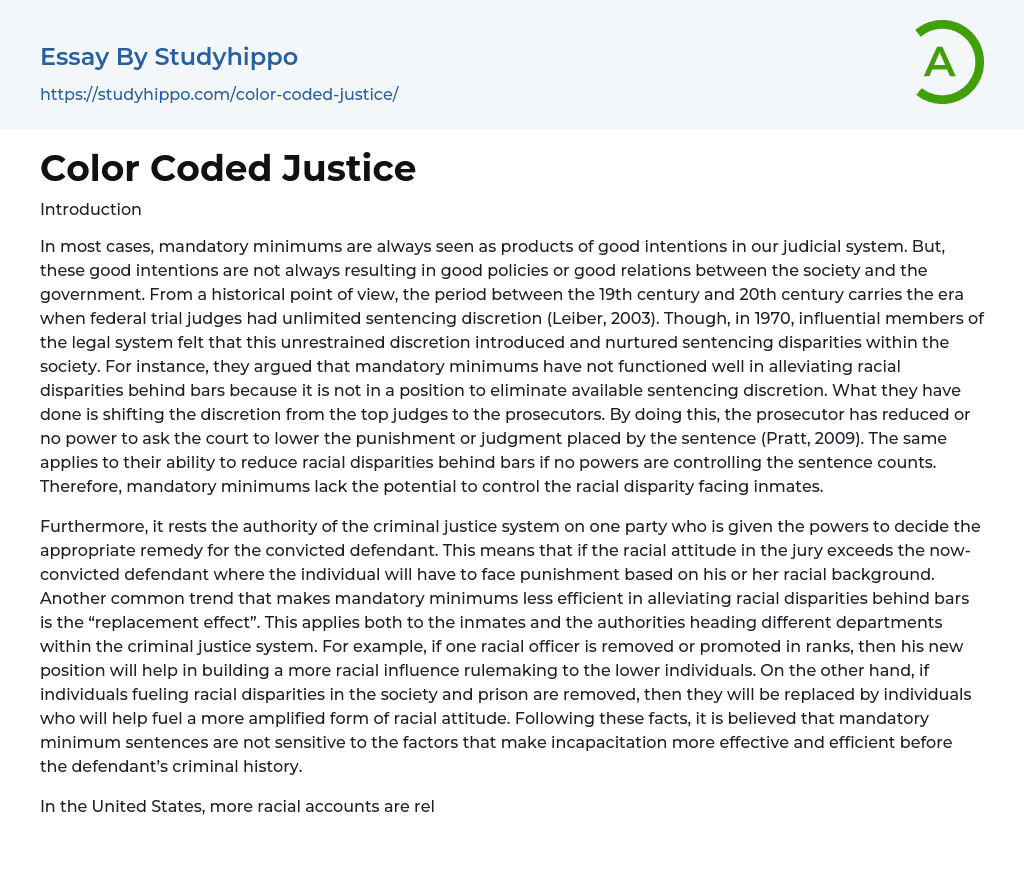Introduction
In our judicial system, mandatory minimums are often viewed as products of good intentions. However, these good intentions do not always lead to favorable policies or positive relationships between society and the government. Historically, between the 19th and 20th centuries, federal trial judges had limitless sentencing discretion (Leiber, 2003). However, in 1970, influential figures within the legal system recognized that this unrestricted discretion resulted in sentencing disparities within society.
The argument made is that mandatory minimums have not been effective in reducing racial disparities in prison because they do not eliminate sentencing discretion. Instead, they shift the discretion from judges to prosecutors. As a result, prosecutors have limited or no power to request lower punishments or judgments. Without the ability to control sentence counts, mandatory minimums are unable to address the racial disparities faced by inmates (Pratt, 2009).
...Furthermore, the criminal justice system relies on one party to determine the appropriate remedy for a convicted defendant, which can result in punishment based on racial background. This contributes to racial disparities within the prison system. Additionally, the "replacement effect" further undermines the effectiveness of mandatory minimums in reducing these disparities. This occurs when individuals with racial biases are either removed or promoted within the criminal justice system, leading to more racially influenced decision-making. Ultimately, removing individuals who contribute to racial disparities can result in their replacement with individuals who amplify racial attitudes.
According to these facts, it is believed that mandatory minimum sentences do not take into account the factors that make incapacitation more effective and efficient in relation to a defendant's criminal history. In the United States, a higher number of racial accounts are associated with drug dealing
and common theft crimes. From a theoretical perspective, it is thought that mandatory minimum sentences assist the government in moving up the chain of major crime operations, such as drug operations, by using convicted lower-level offenders to track senior offenders.
As a consequence of racial definition, offenders who cooperate receive a shorter sentence than what is legally mandated. However, the effectiveness and significance of these mandatory minimums are often exaggerated. This is because the cooperation in such cases is typically subjective, posing challenges in addressing the racial inequalities experienced in prisons. Consequently, there is a risk of more black individuals being imprisoned for life while their white counterparts are released due to the rewards for cooperating with mandatory minimums. Additionally, whenever mandatory minimums are mentioned, it becomes evident that only defendants with strong connections within the top tiers of the Criminal Justice system will receive assistance, further exacerbating racial disparities since most black individuals lack such connections. Jones ; Mauer (2013 p.103) propose one effective solution: providing community services and supervision.
In simpler terms, the text suggests the need for a Community Policing Movement that aligns with the Criminal Justice System. By implementing community policing programs, officials can effectively address issues before they escalate and become problems in society. Racial disparities in prisons begin from the moment a police officer initiates an investigation against a suspect. It is believed that minorities are unfairly targeted as suspects, leading to a distorted racial composition in prisons (Jones ; Mauer, 2013). However, through the adoption of community policing, which involves community members in assessing and managing societal issues, the racial tactics employed by the criminal justice system, including investigators and
police officers, will be reduced. Additionally, community policing will reduce the substantial discretion that police officers have in deciding whom to convict, label as suspicious, or issue warrants for further investigation.
In essence, society supervision is an option that aims to reduce racial harassment in neighborhoods identified by the police as prone to suspicious activity. This option clearly shows that its implementation will lead to a decrease in racial disparities and compositions in prisons compared to mandatory minimum sentencing.
Conclusion
According to Jones ; Mauer (2013), the use of mandatory minimum sentencing is not a cost-effective and efficient method for addressing racial disparities in correctional facilities. Leiber (2013) also shares this concern, arguing that the certainty of suspicion, arrest, hearing, conviction, and punishment has a greater deterrent effect than the complexity of the sentence dictated by law. In many cases, sentencing is influenced by the racial dynamics between the convicted defendant and prominent members of the jury (Leiber, 2003).
Community policing, which includes community service and supervision, is an effective approach to significantly reduce racial disparity in prisons. By addressing the issues that contribute to racial attitudes in society, this method can ultimately lead to positive changes within the criminal justice system.
References
- Jones, S., ; Mauer, M. (2013). Race to Incarcerate: A Graphic Retelling. New York: The New Press.
- Leiber, M. J. (2003). The contexts of juvenile justice decision making: When race matters. Albany: State University of New York Press.
- Pratt, T. C. (2009).
Addicted To Incarceration: Corrections Policy And The Politics Of Misinformation In The United States. Los Angeles: SAGE.




